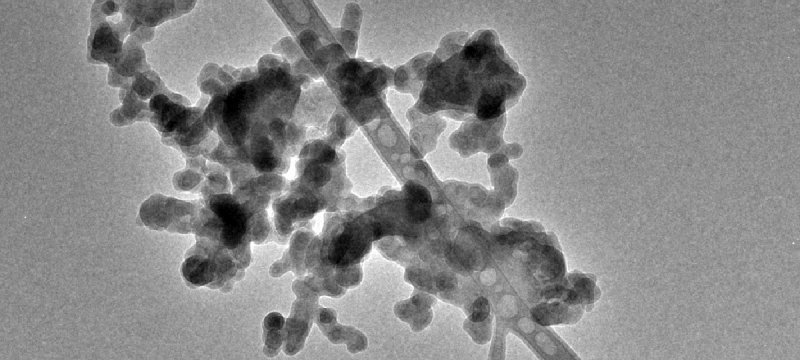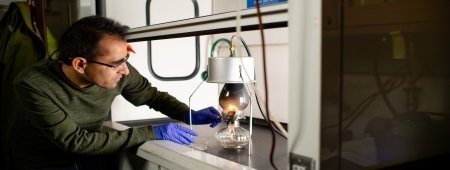New understanding of modeling soot in the atmosphere underscores the importance of reducing carbon emissions.
Black carbon particles — more commonly known as soot — absorb heat in the atmosphere. For years, scientists have known that these particles are affecting Earth’s warming climate, but measuring their exact effect has proved elusive.
Researchers at Michigan Technological University and Brookhaven National Laboratory, along with partners at other universities, industry, and national labs, have determined that while the shape of particles containing black carbon does have some effect on atmospheric warming, it’s important to account for the structural differences in soot particles, as well as how the particles interact with other organic and inorganic materials that coat black carbon as it travels through the atmosphere.
Published today in the Proceedings of the National Academy of Sciences, the article provides a framework that reconciles model simulations with laboratory and empirical observations, and that can be used to improve estimates of black carbon’s impact on climate.
About the Researcher
Every Black Carbon Particle is Unique
Black carbon’s absorption of solar radiation is comparable to that of carbon dioxide. Yet black carbon only remains in the atmosphere for days to weeks, while carbon dioxide can remain in the atmosphere for hundreds of years.
Scientists for years have approximated black carbon particles as spherically shaped in models that frequently became coated by other organic materials. The thought was that as the soot particles travel through the atmosphere, the coating had what is called a “lensing effect”; the coat focuses light down on the black carbon, causing increased radiation absorption. And while soot particles are indeed coated in organic materials, that coating is not uniform from particle to particle.
“When you take an image under the microscope, the particles never look perfectly like a sphere with the same coating,” said Claudio Mazzoleni, professor of physics at Michigan Tech and one of the article’s co-authors. “If you do a numerical calculation about perfect spheres coated by a shell, a model will show an enhanced absorption of the black carbon particles by a factor of up to three.”
Empirical studies of black carbon particles demonstrate that absorption is much less than models would suggest, calling into question the effectiveness of the model as well as our understanding of black carbon’s climate forcing effect.
Research suggests that the organic material coating is not fully spherical; depending on how the organic materials cling to a black carbon particle, the resulting shape can cause the particle to act very differently even if it has the same amount of material as another soot particle that is differently shaped. But even more important is that the amount of coating might change disparately from particle to particle. These two attributes both decrease the expected absorption enhancement.
Collaborators and Facilities
BC4 laboratory study collaborators include Leah Williams, Jesse Kroll, Ellie Browne, Gabriel Isaacman-Wertz, Yatish Parmar, James Brogan, Sara Forestieri, and Noopur Sharma. Other collaborators include Tim Onasch at Aerodyne, Paul Davidovits at Boston College, and Brookhaven and Pacific Northwest national laboratories. Parts of this study were completed using Michigan Technological University’s Applied Chemical and Morphological Analysis Laboratory. The participation of the single-particle soot photometer was made possible by a Department Of Energy ARM small campaign grant.
Laura Fierce, an associate atmospheric scientist at Brookhaven National Laboratory, applied the particle-resolved model to account for particle heterogeneity while modeling black carbon.
“Whereas most aerosol models simplify the representation of particle composition, the particle-resolved model tracks the composition of individual particles as they evolve in the atmosphere,” Fierce said. “This model is uniquely suited to evaluate error resulting from common approximations applied in global-scale aerosol models.”
Less Effect on Climate Warming Than We Thought
Essentially, the researchers have introduced into climate modeling the diversity of organic and inorganic coating on particles and the non-uniform nature of the particles themselves. By combining an empirical model with laboratory measurements, the model predicted a much lower enhancement increase in absorption by black carbon than previously thought. The updated modeling also brings the model’s output much closer to what was measured in the field.
“People think black carbon has a very strong warming effect on the atmosphere, which depends on absorption,” Mazzoleni said. “If you have larger absorption, it contributes to warming and has greater climate impact. To understand how much black carbon contributes to the warming of climate, we need to understand these details because they can make a difference.”
Grants and Funding
DOE DE-SC0011935
This research provides a path forward for improving predictions of black carbon’s radiative effect on climate. Reducing black carbon emissions in the atmosphere can help reduce some of the effects of climate change. The results of this study suggest that a particle’s absorption per mass is lower than previously thought, but how much black carbon is forcing atmospheric warming also depends on emissions levels, interactions with clouds and the distance a particle travels. And while reducing sooty emissions is significant, reducing carbon dioxide in the atmosphere is still of utmost importance.
Michigan Technological University is an R1 public research university founded in 1885 in Houghton, and is home to nearly 7,500 students from more than 60 countries around the world. Consistently ranked among the best universities in the country for return on investment, Michigan's flagship technological university offers more than 185 undergraduate and graduate degree programs in science and technology, engineering, computing, forestry, business, health professions, humanities, mathematics, social sciences, and the arts. The rural campus is situated just miles from Lake Superior in Michigan's Upper Peninsula, offering year-round opportunities for outdoor adventure.







Comments